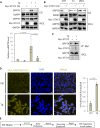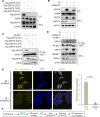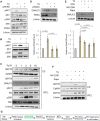ER residential chaperone GRP78 unconventionally relocalizes to the cell surface via endosomal transport
- PMID: 33974094
- PMCID: PMC8254793
- DOI: 10.1007/s00018-021-03849-z
ER residential chaperone GRP78 unconventionally relocalizes to the cell surface via endosomal transport
Abstract
Despite new advances on the functions of ER chaperones at the cell surface, the translocation mechanisms whereby these chaperones can escape from the ER to the cell surface are just emerging. Previously we reported that in many cancer types, upon ER stress, IRE1α binds to and triggers SRC activation resulting in KDEL receptor dispersion from the Golgi and suppression of retrograde transport. In this study, using a combination of molecular, biochemical, and imaging approaches, we discovered that in colon and lung cancer, upon ER stress, ER chaperones, such as GRP78 bypass the Golgi and unconventionally traffic to the cell surface via endosomal transport mediated by Rab GTPases (Rab4, 11 and 15). Such unconventional transport is driven by membrane fusion between ER-derived vesicles and endosomes requiring the v-SNARE BET1 and t-SNARE Syntaxin 13. Furthermore, GRP78 loading into ER-derived vesicles requires the co-chaperone DNAJC3 that is regulated by ER-stress induced PERK-AKT-mTOR signaling.
Keywords: Endoplasmic reticulum stress; Endosome; GRP78; Unconventional trafficking.
Conflict of interest statement
The authors do not have any competing interests.
Figures









Similar articles
-
Endoplasmic reticulum stress activates SRC, relocating chaperones to the cell surface where GRP78/CD109 blocks TGF-β signaling.Proc Natl Acad Sci U S A. 2018 May 1;115(18):E4245-E4254. doi: 10.1073/pnas.1714866115. Epub 2018 Apr 13. Proc Natl Acad Sci U S A. 2018. PMID: 29654145 Free PMC article.
-
MT1-MMP recruits the ER-Golgi SNARE Bet1 for efficient MT1-MMP transport to the plasma membrane.J Cell Biol. 2019 Oct 7;218(10):3355-3371. doi: 10.1083/jcb.201808149. Epub 2019 Sep 13. J Cell Biol. 2019. PMID: 31519727 Free PMC article.
-
Cell surface relocalization of the endoplasmic reticulum chaperone and unfolded protein response regulator GRP78/BiP.J Biol Chem. 2010 May 14;285(20):15065-15075. doi: 10.1074/jbc.M109.087445. Epub 2010 Mar 5. J Biol Chem. 2010. PMID: 20208072 Free PMC article.
-
Pathogenic Effects of Impaired Retrieval between the Endoplasmic Reticulum and Golgi Complex.Int J Mol Sci. 2019 Nov 9;20(22):5614. doi: 10.3390/ijms20225614. Int J Mol Sci. 2019. PMID: 31717602 Free PMC article. Review.
-
Retrograde traffic from the Golgi to the endoplasmic reticulum.Cold Spring Harb Perspect Biol. 2013 Jun 1;5(6):a013391. doi: 10.1101/cshperspect.a013391. Cold Spring Harb Perspect Biol. 2013. PMID: 23732476 Free PMC article. Review.
Cited by
-
Cellular stress modulates severity of the inflammatory response in lungs via cell surface BiP.Front Immunol. 2022 Nov 18;13:1054962. doi: 10.3389/fimmu.2022.1054962. eCollection 2022. Front Immunol. 2022. PMID: 36466830 Free PMC article.
-
CDNF Exerts Anxiolytic, Antidepressant-like, and Procognitive Effects and Modulates Serotonin Turnover and Neuroplasticity-Related Genes.Int J Mol Sci. 2024 Sep 26;25(19):10343. doi: 10.3390/ijms251910343. Int J Mol Sci. 2024. PMID: 39408672 Free PMC article.
-
GRP78, a Novel Host Factor for SARS-CoV-2: The Emerging Roles in COVID-19 Related to Metabolic Risk Factors.Biomedicines. 2022 Aug 17;10(8):1995. doi: 10.3390/biomedicines10081995. Biomedicines. 2022. PMID: 36009544 Free PMC article. Review.
-
Secretory defects in pediatric osteosarcoma result from downregulation of selective COPII coatomer proteins.iScience. 2022 Mar 17;25(4):104100. doi: 10.1016/j.isci.2022.104100. eCollection 2022 Apr 15. iScience. 2022. PMID: 35402877 Free PMC article.
-
Unconventional Protein Secretion in Brain Tumors Biology: Enlightening the Mechanisms for Tumor Survival and Progression.Front Cell Dev Biol. 2022 Jun 15;10:907423. doi: 10.3389/fcell.2022.907423. eCollection 2022. Front Cell Dev Biol. 2022. PMID: 35784465 Free PMC article. Review.
References
-
- Gopal U. (2018) The endoplasmic reticulum chaperone GRP78 also functions as a cell surface signaling receptor. In: Cell surface GRP78, a new paradigm in signal transduction biology, pp 9–40. 10.1016/B978-0-12-812351-5.00002-7
MeSH terms
Substances
Grants and funding
LinkOut - more resources
Full Text Sources
Other Literature Sources
Medical
Research Materials
Miscellaneous

